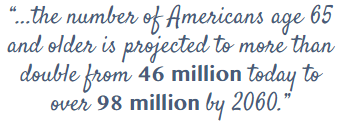We all have those moments when our careers and personal lives converge. As a business leader at the largest health care real estate investment trust (REIT), I focus on investment projects in collaboration with senior living communities, health systems and medical groups to create the real estate infrastructure needed to deliver care for a growing number of aging Americans. As a wife, mother, sister and daughter, I also think about what my parents, aging relatives and even my future 80-year-old self will need when it comes to living well as we age.

The growth of the aging population is the most significant demographic trend impacting the U.S. According to the Population Reference Bureau, the number of Americans age 65 and older is projected to more than double from 46 million today to over 98 million by 2060. In addition, the number of people age 85 and older is projected to more than triple from 6 million today to nearly 20 million by 2060.
This increase in life expectancy is accompanied by an increased prevalence of chronic conditions, including dementia. According to the CDC, in the United States alone, more than a quarter of older Americans are burdened with multiple chronic disease, more than 5 million Americans are living with Alzheimer’s disease and countless family members spend their days serving as unpaid caregivers. The most expensive and at risk population for the health care system to treat are the physically and cognitively impaired. We need to rethink how to best deliver care for this growing segment of the population.
Consider that, in many cases, the frail elderly and people with dementia are living in settings that put them at risk. A large two-story, suburban house is filled with potential health hazards and risks. Any resulting injuries will be costly for a traditional hospital to manage, especially considering the limited number of days for which they will be reimbursed.
Compounding this issue, some health systems today have an antiquated infrastructure that does not support modern technologies, such as a reliable Wi-Fi signal. Furthermore, the investment required for such upgrades is enormous. Old real estate is a burden to providers and becomes an obstacle to progress.
Investment in health care infrastructure is allowing us to re-imagine and fund the evolution of lower cost, higher impact health care delivery models. Acute and senior care providers will need to work together, and real estate can be a bridge in that effort.
Take the “Medical Mile” in Voorhees, NJ, an affluent suburb of Philadelphia. Welltower and three of its partners came together to build a state-of-the-art, collaborative model of health care delivery comprised of a senior living community, a large non-profit health care system and a post-acute rehabilitation facility. The Medical Mile benefits patients, our three partners and the community as a whole by providing easily accessible, state-of-the-art medical facilities across the continuum.
These distinct providers agreed to collaborate with each other to achieve better transitions of care. A resident living in the senior living community can have a knee replacement at the outpatient medical facility and then travel half a mile down the road to receive excellent post-acute care—avoiding acute care settings altogether and improving patient care.
Another recent development in health care builds on the trend of seniors wishing to age in cities. Urban centers with a high quality of life are experiencing double-digit growth of the aging population. According to New York City’s Department for the Aging Changes in the Elderly Population of New York City 2000 to 2010, the population over 60 in New York City increased by more than 12 percent, or six times faster than the city’s total population growth. In Manhattan, the growth rate of the city’s 60-plus population was 20 percent.
Despite the incredible population growth, Manhattan is one of many vastly underserved locations when it comes to quality senior care: its availability of assisted living facilities is five times below the national average and there are fewer than 75 licensed memory care beds on the island. This is why Welltower, in partnership with Hines, is building an assisted living and memory care community in the heart of Manhattan, which will be managed by Sunrise Senior living.
I am fortunate to have the opportunity to help shape the future of health care. It is incredibly energizing to bring partners, ideas and capital together to create positive change, especially when it benefits our senior population. As a female real estate executive, I take pride in the work we do at Welltower, where we are advancing both commercial and social objectives. The satisfaction that results brings balance to my work, and this adds to my personal life.
Mercedes Kerr
Executive Vice President
Business & Relationship Management Welltower Inc.

 Login
Login
